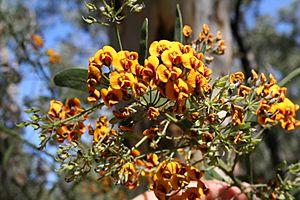Narrow leaf bitter pea facts for kids
Quick facts for kids narrow leaf bitter pea |
|
|---|---|
 |
|
| Scientific classification | |
| Kingdom: | |
| (unranked): | |
| (unranked): | |
| (unranked): | |
| Order: | |
| Family: | |
| Genus: | |
| Species: |
D. corymbosa
|
| Binomial name | |
| Daviesia corymbosa Sm.
|
|
| Synonyms | |
|
Daviesia macrophylla Endl. |
|
The narrow leaf bitter pea (Daviesia corymbosa) is a type of flowering plant that belongs to the Fabaceae family, also known as the pea family. This plant is native to the state of New South Wales in eastern Australia. It grows as a shrub, reaching up to 2 meters (about 6.5 feet) tall. You can often find it in sandy soils within open eucalyptus forests or heathlands. In spring and early summer, it produces bright, eye-catching flowers that are a mix of red and yellow.
Contents
About the Plant's Name
The narrow leaf bitter pea was officially described in 1805 by an English botanist named James Edward Smith. He gave it the name Daviesia corymbosa. The genus name, Daviesia, was chosen to honor a Welsh botanist named Hugh Davies. The second part of its name, corymbosa, refers to how its flowers are arranged in a special cluster called a corymb.
This plant is closely related to other bitter pea species like D. latifolia, D. laevis, and D. laxiflora. Sometimes, it can even mix with D. latifolia and D. ulicifolia to create new hybrid plants.
What the Plant Looks Like
The narrow leaf bitter pea grows as an open shrub and can reach up to 2 meters (about 6.5 feet) in height. Unlike many plants, it doesn't have true leaves. Instead, it has special flattened stems called phyllodes. These phyllodes can be different shapes, from egg-shaped to long and narrow. They are usually between 2 and 12 centimeters (about 0.8 to 4.7 inches) long and 0.2 to 2.5 centimeters (about 0.08 to 1 inch) wide. They are green and have a clear pattern of veins.
Its beautiful yellow to red flowers appear from August to December, but they are most common in spring, especially in September and October. These flowers grow in groups of 5 to 20, arranged in clusters that look like umbrellas or corymbs. After the flowers, the plant produces seed pods, which are ready in November and December.
You can tell Daviesia corymbosa apart from other bitter pea species by its unique flower clusters. Also, its bright green phyllodes are different from the pale grey-green phyllodes of plants like D. laevis and D. latifolia.
Where the Plant Grows
The narrow leaf bitter pea is found only in New South Wales, Australia. It grows on sandy soils to the east of the Great Dividing Range, stretching from Myall Lakes down to Green Cape. It prefers dry sclerophyll forests or heathlands.
In these areas, you might find it growing alongside other trees like red bloodwood (Corymbia gummifera), yellow bloodwood (C. eximia), narrow-leaved apple (Angophora bakeri), smooth-barked apple (A. costata), and silvertop ash (Eucalyptus sieberi). Near creeks, you might also see watergum (Tristaniopsis laurina) and scrub beefwood (Stenocarpus salignus).
Plant Life and Interactions
The narrow leaf bitter pea has a clever way to survive bushfires: it can regrow from its roots after a fire. It also plays an important role for certain insects. It is a host plant for a type of jewel beetle called Ethonion jessicae. The young beetles (larvae) live inside special growths called galls on the stems of the bitter pea plant.
Growing the Plant
Bitter peas from the Daviesia genus are not very common in gardens. However, D. corymbosa is a very attractive plant when it's flowering. If you want to grow it, it does best in soil that drains well and can be placed in a sunny spot or a place with some dappled shade. You can start new plants from seeds or by taking cuttings from an existing plant.

